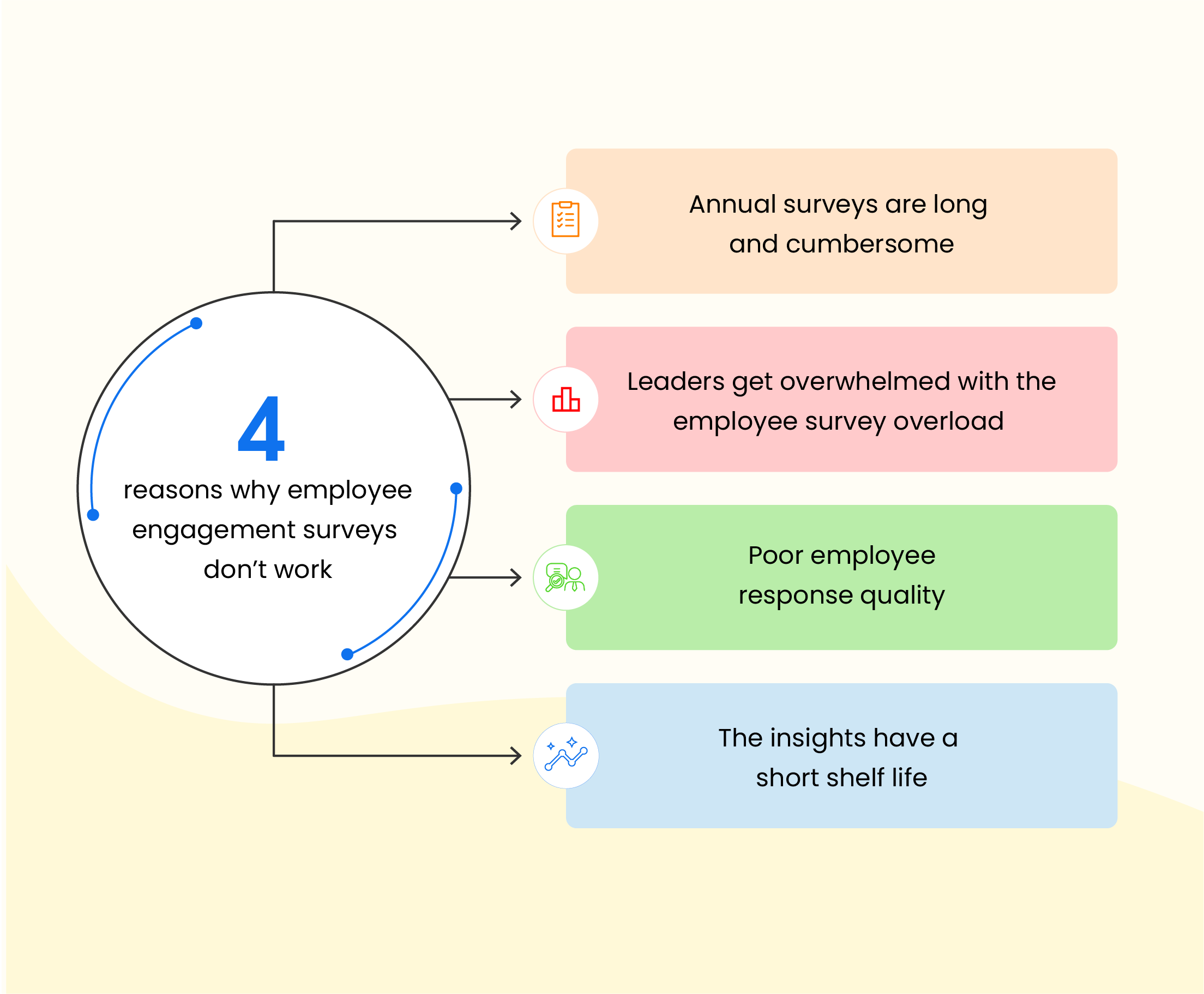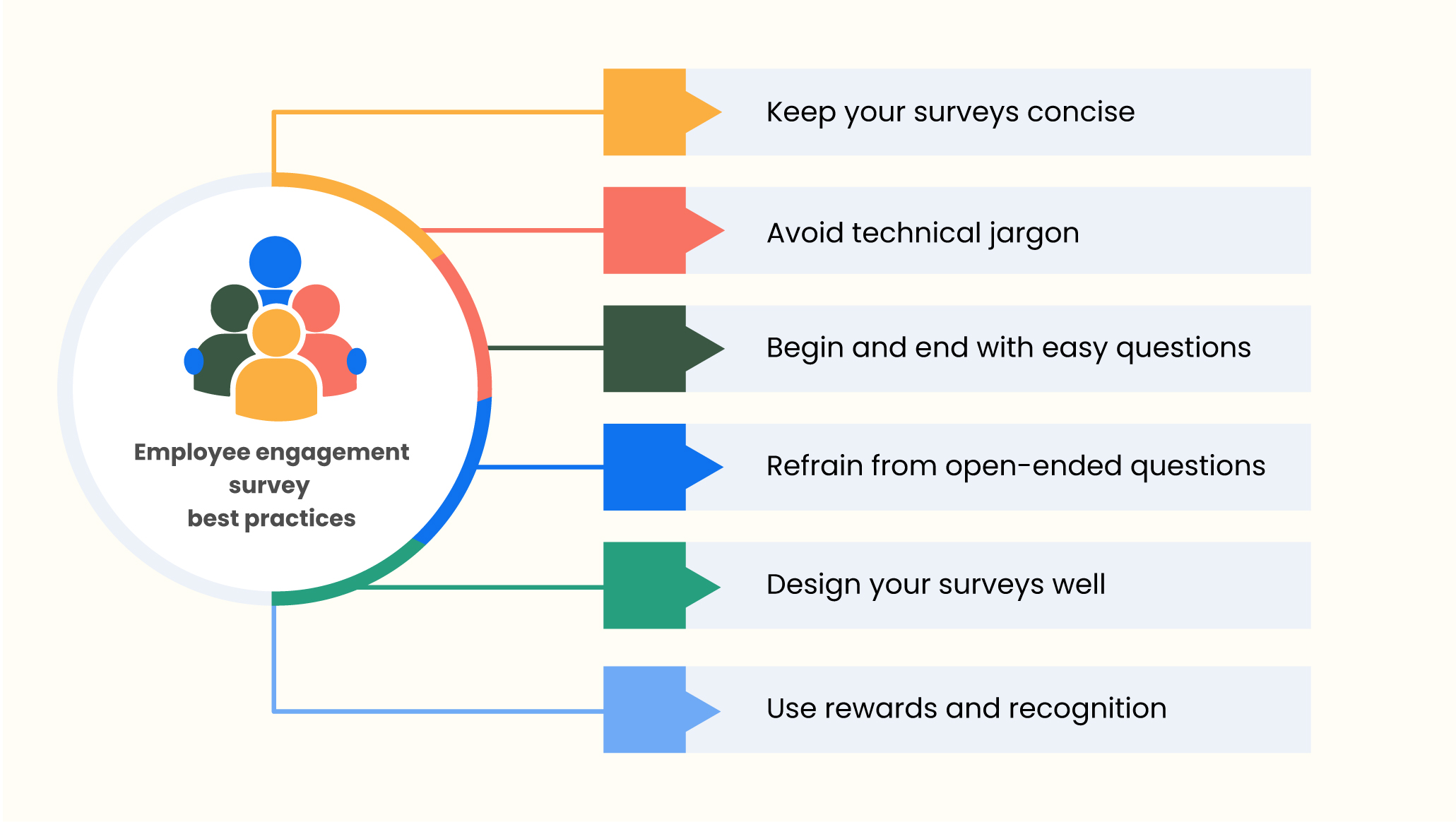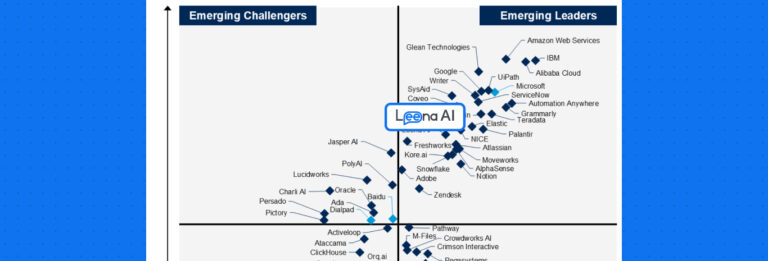Improving the employee experience is now a primary concern for most organizations. One of the most powerful tools that is helping HR leaders and organizations achieve this goal is employee engagement surveys. Some organizations delve deep into their employees’ mindset every week, while some narrow down employee feedback every month. Consequently, the most common question being asked around this subject is, what is the ideal employee engagement survey frequency?
Conducting employee engagement surveys is really important to evaluate how your employees are feeling, what are the issues they are facing, and how you can resolve those issues. The surveys can even gauge the impact of your initiatives and identify any emerging workforce challenges. But, what is the ideal frequency that needs to be adopted? A frequency that does not let you miss out any important triggers that might cost you in future.
This blog is going to dive deeper into this question and help you decide, how often you should conduct employee engagement surveys, what are the challenges associated with the traditional annual surveys, and what are some new-age employee engagement survey practices you cannot afford to miss.
What’s the existing state of annual surveys?
Many organizations still rely on an annual employee engagement survey frequency to determine how their workers are feeling. The problem with annual surveys is that the data collected through them is not concrete in this fast-paced work environment. Because by the time an organization is able to seek feedback, identify the problem, and plan actions to address it, there is a high chance that the employees have already left for a better workplace and opportunity.
So, in a world where changes are ubiquitous and instant, annual surveys might be counterproductive because their results are almost outdated by the time the findings are implemented. This makes it a redundant activity even if the organization had a noble intent.
Why annual employee engagement surveys fall short?
Annual employee engagement surveys are a great idea in theory. In practice, however, they do not reap the desired results that the management aims for.
Here are four main reasons why:

Annual surveys are long and cumbersome
Annual employee engagement surveys are often long and cumbersome, eroding valuable time and resources of the organization. Many times HRs ask endless questions, and try to address too many issues at once. Annual surveys, when not managed and implemented correctly, become counterproductive. And, provide data that is too much to handle and might lose relevance next year. Annual surveys, are therefore, not recommended as an appropriate frequency to measure employee engagement.
Poor employee response quality
The longer a survey is, the more likely employees will get bored or distracted, which means their responses won’t be as thoughtful or honest as they should be. Additionally, employees do not want to give honest feedback because they do not want to hurt anyone’s feelings or get into a conflict with the management.
Leaders get overwhelmed with the annual survey response
When an organization gets hundreds of responses back from employees (most of which may be negative), they are not prepared to deal with the resulting fallout of unhappy employees. Consequently, employees feel ignored and unheard by their management. This is followed by employees losing their trust in the management and a decrease in the participation rate.
The insights have a short shelf life
The insights from these annual surveys have a short shelf life, which means that by the time the analysis is shared with the team, the data collected is already outdated. Moreover, if the insights never see the light of the day and no actions are taken as a response to the feedback survey, employees feel disenfranchised by the process.
What is the ideal frequency to measure employee engagement?
How often to run an employee engagement survey? Honestly, it depends!
The best time to send out a survey depends on your business objectives, your workforce, and even your industry. You can consider weekly, pulse, monthly, quarterly, or half-yearly surveys—each with its own benefits and drawbacks. But in order to find the right match for you, you need to test out different frequencies and then find the right frequency to measure employee engagement that works.
In order to make this process easier, we recommend using pulse surveys: short surveys, with not more than 5-7 questions, that are sent out regularly (usually weekly) so that employees can provide feedback at any time during the week.
Pulse surveys are great because they allow managers to get timely feedback from their teams without having to wait for a longer survey cycle. And because they are short and simple enough for employees to complete quickly, managers can timely act on the feedback.
Pulse surveys too can be conducted at various intervals based on their objectives and are a great way to follow up after your baseline employee engagement survey. Here are some use cases explained for different types of surveys to help you put things in perspective:
- Weekly surveys are a great way to ensure managers across all teams are catching up with their team members to align on tasks, progress, and possible roadblocks.
- Monthly surveys are great for evaluating the performance and learnings, as well as recognizing the accomplishments of team members.
- Quarterly surveys can be used to touch base with individual employees and ask them about their job satisfaction, discuss what turned out great, what could be better, set KPIs for the next quarter, etc.
- Half yearly surveys can be used to gauge vision alignment, suggest improvements in company facilities, culture, policies etc.
“We conduct an employee pulse survey once a month. These are shorter, regular employee opinion surveys, typically consisting of 10-15 questions that take us no more than a few minutes to complete. We use pulse surveys to follow up on and track progress from the results of our baseline engagement survey.” – Tracy Acker, CEO, GetPaydayLoan
How to use pulse surveys for employee engagement?
As the name “pulse” suggests, these surveys are circulated to continuously gain insight on subjects such as employee job-role, communication and relationship among the workforce, and the overall work environment. These quick surveys allow organizations to measure and compare feedback regularly and analyze the effect of their engagement initiatives.
Pulse surveys comprise a standardized questionnaire aimed at assessing how employees feel about their workplace. It usually takes less than an hour to complete, and the results can be used as part of a larger HR strategy that further improves performance and morale.
The pulse surveys play a pivotal role in helping you understanding what your employees are thinking, feeling, and doing at the moment. When you conduct an employee pulse survey, you are asking employees a series of questions about their workplace experience, their perception of the company culture and values, and their personal goals.
The answers you get from these questions can help you identify areas where your company needs improvement—and give you the data you need to make those improvements happen.
Pulse surveys are also useful because they’re easy to take: typically just one or two questions each day over the course of several weeks or months. This makes it convenient for employees who want to provide feedback but don’t have time for long surveys or interviews.
“Running regular pulse surveys are great for understanding and measuring how the team is feeling and identifying any potential issues. Running these surveys gives us valuable information, but to make sure it isn’t just a data-gathering exercise, we also always produce a feedback summary and make sure that we act on any issues raised.” – James Parkinson, Head of Marketing Content, Personnel Checks
Here’s why pulse surveys work better than any other surveys:
It increases the response rate of employees
Pulse surveys are designed to be short and lightweight so they do not take much time to fill, which means you will get quicker responses. More responses mean more data and better insights into what is going on in your organization.
Enables faster problem-solving
Pulse surveys will ask specific engagement questions about how employees currently feel or what they currently think—and get specific answers—so you will be able to nip the bud before it turns into a larger issue.
Increases employee engagement
When organizations seek and act on feedback frequently, employees see their feedback being acknowledged and acted on quickly. It allows them to believe that their opinions are being valued. Moreover, when smaller issues get resolved frequently, employees feel they are an important part of the organization which ultimately enhances their productivity and encourages them to do their best.
What are the best practices to conduct employee engagement surveys?
Employee feedback surveys are a great way to connect with your workforce, understand their opinion, ensure they are satisfied, and to measure the effectiveness of your employee engagement initiatives. But how do you ensure that your method of conducting surveys is correct? Here are some best practices to keep in mind if you want to make sure your surveys are as effective as possible:

Keep the survey concise
You might wonder how long should a survey run. Well, a short survey takes less time for employees to fill out! Moreover, a shorter survey means that you will get an answer more quickly, so you can make changes sooner and get better results in the long run.
Try integrating an employee engagement platform that creates crisp and straightforward surveys. You can seamlessly customize the surveys as per your organization’s needs using these platforms.
Avoid using crafty terms
Don’t confuse your employees by using manipulative words they don’t understand or don’t care about. Be sure to use terms that are familiar and understandable by all stakeholders involved in the survey process and give them a chance to ask questions if anything doesn’t make sense before moving on!
Begin and end with questions that matter
You don’t want your respondents getting frustrated before they even get started! Start off with easy questions that do not require too much thought on the part of participants before asking more. This will let people know that this is an easy process, encouraging them to keep going through the survey until they reach the end!
Refrain from asking open-ended questions
Open-ended questions can be difficult for respondents. They should only be asked as follow up questions where necessary. Instead, ask questions with multiple choices or a Likert scale (where respondents answer on a scale from strongly agree to strongly disagree). This makes the response rate go higher, insights more actionable, and improvement actions more prompt.
Design your surveys well
Even if you are not a subject matter expert yourself , remember that a good survey design can make or break the impact it creates—and if it breaks, then what’s the point? A clean layout and a smooth flow can help respondents feel more comfortable while taking your survey and help them provide more accurate answers as well!
Add a thank you note
Finally, make sure to thank your respondents for the time and effort they put into filling out the survey. This will make them feel valued, which is an important part of keeping them engaged with their work and company.
Analyze the responses
After you are done receiving feedback from your employees. The immediate step to take is to segment the data and start analyzing. It is the most important part of conducting surveys. Analyzing the feedback of your employees will help you predict attrition and identify improvement areas.
Build an action plan
Prepare your future action plan on the basis of the responses put together, and the conclusions drawn. Customize your next initiative accordingly and start executing the changes.
READ MORE: A detailed guide on building effective employee engagement surveys.
Wrapping Up
By now, you must have understood that an annual employee engagement survey frequency is not the ideal cadence. If you really want to see a change in the engagement levels of your workforce and understand when is the best time to conduct a survey, you need to reevaluate your employee engagement survey frequency. You should ask fewer questions on a regular basis, for more valuable insights that can be easily turned into actionable.
But, if you are wondering how this new initiative is going to fit into your already packed schedule and overworked HR team. Well, technology has made it possible for you to relieve your HRs of the manual and tedious work of creating and sending out surveys or spending hours analyzing the responses. All you need is one tool that enables you to automate the circulation of surveys, collect feedback, and analyze the data.
One such tool is Leena AI’s employee engagement survey platform, which enables HRs to conduct surveys with the utmost ease. Leena AI‘s engagement surveys are simple, intuitive, employee-friendly, and tailored to ensure maximum participation rate through its conversational AI-backed interface. The simple conversational surveys help you find the key engagement drivers at every level of the organization and allows you to build an action plan accordingly.
Here’s what Leena AI’s intelligent employee engagement platform promises:
- Customizable questions for every stage of the employee lifecycle
- Real-time actionable insights
- Efficient action planning
- Employee feedback analysis
- Reduction in unwanted attrition
- Easy integration with 100+ popular channels like Slack, WhatsApp, MS Teams, and more
Book a free demo today to find out why Leena AI should be your engagement survey platform for better business outcomes.
Get in-depth insights into what your employees think about you.
Schedula a demo todayFrequently Asked Questions
What should be employee engagement survey frequency?
A survey should be conducted frequently enough that you can use it to make informed decisions, but not so often that the results are meaningless. We recommend that you conduct employee surveys quarterly, to ensure that you have the most up-to-date information about the state of your workplace.
What makes a good employee engagement survey?
A good employee engagement survey should feature employee-centric questions. The survey should be short and concise. It should be easily filled out in 10 minutes or less. Finally, a good employee engagement survey should cover all aspects of employee satisfaction including benefits, management style, workload, and pay level.
How long should an employee engagement survey be?
An employee engagement survey should be long enough to capture all the data you need, but not so long that it’s cumbersome and takes too much time. However, it also depends on what kind of surveys you are sending. While pulse surveys don’t usually have more than 5-7 questions because of their frequency, half-yearly and annual surveys can be much longer than that because of the variety of topics they cover.
Why should employee engagement surveys be conducted frequently?
Employee engagement surveys should be conducted frequently because they are an effective tool that can help bring changes in the workplace. These surveys can be used to identify areas where employees would like to see improvements and make those changes, which will benefit everyone involved.







1 Comment